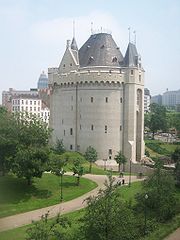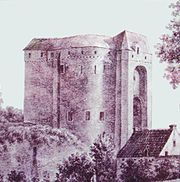
Halle Gate
Encyclopedia

Dutch language
Dutch is a West Germanic language and the native language of the majority of the population of the Netherlands, Belgium, and Suriname, the three member states of the Dutch Language Union. Most speakers live in the European Union, where it is a first language for about 23 million and a second...
) is a medieval fortified city gate
City gate
A city gate is a gate which is, or was, set within a city wall. Other terms include port.-Uses:City gates were traditionally built to provide a point of controlled access to and departure from a walled city for people, vehicles, goods and animals...
of the second walls of Brussels
Second walls of Brussels
There were two stages of fortifications of Brussels, the first walls, built in the early 13th century, and the second walls, built in the late 14th century and later upgraded. Today, only a few sections of either remain.-First walls:...
.
Built in 1381, Halle Gate is a 14th century city gate
City gate
A city gate is a gate which is, or was, set within a city wall. Other terms include port.-Uses:City gates were traditionally built to provide a point of controlled access to and departure from a walled city for people, vehicles, goods and animals...
from the second set of defensive walls
Second walls of Brussels
There were two stages of fortifications of Brussels, the first walls, built in the early 13th century, and the second walls, built in the late 14th century and later upgraded. Today, only a few sections of either remain.-First walls:...
that enclosed Brussels
Brussels
Brussels , officially the Brussels Region or Brussels-Capital Region , is the capital of Belgium and the de facto capital of the European Union...
. The gate was named for the city of Halle
Halle, Belgium
Halle , is a Belgian city and municipality in the district Halle-Vilvoorde of the province Flemish Brabant. The city is located on the Brussels-Charleroi Canal and on the Flemish side of the language border that separates Flanders and Wallonia...
in Flemish Brabant
Flemish Brabant
Flemish Brabant is a province of Flanders, one of the three regions of Belgium. It borders on the Belgian provinces of Antwerp, Limburg, Liège, Walloon Brabant, Hainaut and East Flanders. Flemish Brabant also completely surrounds the Brussels-Capital Region. Its capital is Leuven...
which it faces.
The original gate included a portcullis
Portcullis
A portcullis is a latticed grille made of wood, metal, fibreglass or a combination of the three. Portcullises fortified the entrances to many medieval castles, acting as a last line of defence during time of attack or siege...
and drawbridge
Drawbridge
A drawbridge is a type of movable bridge typically associated with the entrance of a castle surrounded by a moat. The term is often used to describe all different types of movable bridges, like bascule bridges and lift bridges.-Castle drawbridges:...
over a moat
Moat
A moat is a deep, broad ditch, either dry or filled with water, that surrounds a castle, other building or town, historically to provide it with a preliminary line of defence. In some places moats evolved into more extensive water defences, including natural or artificial lakes, dams and sluices...
. The structures that housed these are still visible.
While the other six gateways and the defensive walls were demolished, the Halle Gate survived as it was used as a prison
Prison
A prison is a place in which people are physically confined and, usually, deprived of a range of personal freedoms. Imprisonment or incarceration is a legal penalty that may be imposed by the state for the commission of a crime...
. It was at other times used as a customs
Customs
Customs is an authority or agency in a country responsible for collecting and safeguarding customs duties and for controlling the flow of goods including animals, transports, personal effects and hazardous items in and out of a country...
house, for grain storage, and a Lutheran church.
19th Century Restoration
The architect Henri Beyaert restored the building between 1868 and 1870, changing the austere medieval tower with more romantic Neo Gothic embellishments. The outer entrance, now facing Saint-GillesSaint-Gilles, Belgium
Saint-Gilles or Sint-Gillis is one of the nineteen municipalities located in the Brussels-Capital Region of Belgium.Saint-Gilles has a multicultural identity stemming from its diverse population...
, is closer to the original appearance. In front of the inner gate, facing the city of Brussels, Beyaert added a circular tower topped by a conical roof, containing a monumental spiral staircase. Beyaert also added turrets and a large roof.
Museum

Belgium
Belgium , officially the Kingdom of Belgium, is a federal state in Western Europe. It is a founding member of the European Union and hosts the EU's headquarters, and those of several other major international organisations such as NATO.Belgium is also a member of, or affiliated to, many...
's Musée Royal d'Armures, d'Antiquités et d'Ethnologie (Museum of Armour, Antiquity and Ethnology), now named the Royal Museums for Art and History. By 1889, the Halle Gate was too small to house most of the collection, and most was relocated to the Cinquantenaire Museum
Cinquantenaire Museum
The Cinquantenaire Museum or Jubilee Park Museum is located in the Cinquantenaire park in Brussels, Belgium. It is part of the Royal Museums for Art and History, which is a Belgian federal institute of the Belgian Federal Science Policy Office ....
. It continued to display armour and weapons.
In 1976, the building was in a dangerous state of disrepair and was closed. Finally renovations began, and the Gate was reopened in 1991. Further restoration was stalled by lack of money, and the museum only housed temporary exhibitions.
In March 2007 a new extensive restoration was begun. The Halle Gate finally reopened on June 6, 2008. Finally the St Gilles (drawbridge) entrance was opened as the prestigious main entrance to the building. The museum includes exhibits about the history of the building, and of the city of Brussels and its defence. The collection includes the parade armor of Archduke Albert of Austria (1559-1621). The main parts of the museum, each on a separate floor, are:
- Armour and Armaments, in a small room off the central passage.
- the Gothic Room, above, containing the history of the fortifications of Brussels and of the Halle Gate
- the Guilds Room, showing the role of the trade guilds of the city
- a temporary exhibition space
- a walkway round the battlements, offering a panorama of the city
- the roof space for small exhibitions
External links
- http://www.kmkg-mrah.be/newfr/index.asp?id=601, official site (in French and Dutch)
- http://www.buildingsagency.be/realisatieberichten_fr.cfm, federal building agency responsible for renovations (in French and Dutch)

